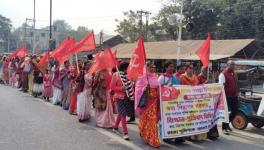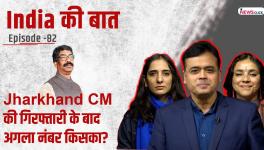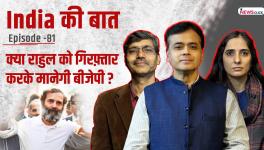Decoding Governor-Government Conflict in West Bengal

Image Courtesy: Wikipedia
A farce of the worst kind—though neither unique nor for the first time—is playing out in the politics of Bengal. The newly-appointed Governor Jagdeep Dhankhar is engaged in a worsening battle of words with Chief Minister Mamata Banerjee and her government.
It started with the governor getting involved in the Babul Supriyo episode at Jadavpur University (JU). It moved on to alleged “disregard and insult” of him during the Durga Puja carnival organised by the state government. And now, it is casting a shadow over the visit of the governor to the districts. These conflicts are sad, avoidable, despicable and churlish, to say the least and set a bad precedent that both sides should step back and reflect on.
Dhankhar, a 68-year old senior Supreme Court advocate, Bharatiya Janata Party (BJP) leader and former Union minister has been a Member of Parliament (MP) and legislator from Rajasthan. He succeeded the 84-year old former Speaker of the Uttar Pradesh Assembly, Keshari Nath Tripathi around three months ago. Tripathi was appointed governor in July 2014, and he also had several run-ins with Banerjee, her government and her party, the Trinamool Congress (TMC).
The TMC made several public demands for Tripathi’s recall, on grounds that he had allegedly “transformed the Raj Bhavan into an RSS shakha”. When Dhankhar was appointed, some in Bengal government had said that they had expected a saffron hardliner in his place, for the relationship between the state administration and the Centre had been steadily worsening. They had felt that the appointment of Dhankhar, who has had stints in the Congress and the Janata Dal before he joined the BJP, may help ease the tensions. “Being a successful advocate, he will certainly know his limits. In the past, the state government had accused some governors of crossing constitutional limits. That had been a cause of conflict between the ruling establishment and Raj Bhavan. This time, it is expected that the tensions will ease,” so said a senior state government official who is close to the chief minister.
Ninety days later the situation seems worse than in Tripathi’s time.
After the JU fracas and the Durga puja episode, the governor asked for special security. The Union Home Ministry on Thursday granted him ‘Z’ class VIP security after he suggested “potential threats” to himself. He had also alleged that he was “blacked out” by the media during the carnival, which he said reminded him of the Emergency. The TMC, denying his allegations, has called the governor a “publicity-monger”.
Lately, the governor was dismayed over the state administration’s “lukewarm” response during his maiden visit to north Bengal. During this day-long trip, Dhankhar met the Darjeeling district administration in Siliguri, but none of the elected TMC leaders of the region met him. This week, the governor has expressed unhappiness over the North 24-Parganas district administration telling Raj Bhawan that sending invitations to district officials, MPs and MLAs to meet the governor was not possible without permission from the state government. The district collector’s letter in this regard says, “...all senior government functionaries will be in North Bengal from October 21 to 23 for administrative review meetings of the Chief Minister...” Dhankhar termed the absence of district officials “unconstitutional” and broadly hinted at some sort of “censorship” taking place in the state. Such conflicts may escalate in coming days and months.
The relationship between the governor of an Indian state and its chief minister are clearly stated in Article 163 of the Constitution: The governor shall act “in accordance to the aid and advice of the Chief Minister” in normal times. Article 356 says that he can exercise his discretion to impose President’s rule, if there is a breakdown in the constitutional machinery or law and order in the state.
Article 164 clearly states that the Council of Ministers is responsible to the Legislative Assembly—meaning that the government remains in power so long as it enjoys majority in the Assembly. Finally, Article 167 says that the chief minister is supposed to communicate to the governor all major decisions of the cabinet; and the governor can ask the chief minister about any issue regarding the state. The entire arrangement ensures that checks and balances are in place. The governor is the first citizen of the state, but the chief minister is the elected chief executive in practice, and in normal situations the governor does not interfere in its day-to-day functioning.
This is for the books. The reality has been grim. The gubernatorial position had often been used both by the two major national parties, the Congress and the BJP, to buttress their respective political goals in various states since the 1970s, specially by former prime minister (PM) Indira Gandhi and the present PM, Narendra Modi—the two most power-centralising leaders the nation has seen. Congress governments, specially under Gandhi, had invoked Article 356 through various state governors to impose central rule in Kerala, Jharkhand, even West Bengal, and other states. The Modi government has used similar tactics to get rid of governments in Uttarakhand and Arunachal Pradesh, though the Supreme Court later reversed both decisions.
Even West Bengal has had a chequered history of governor-government conflicts. After the United Front government in the state got dismissed on 21 November 1967 by the then governor, Dharam Veer, it returned to power in 1969. The governor’s speech, which was scheduled to be delivered after the council of ministers was formed, contained a paragraph criticising Dharam Veer. However, the governor refused to read that portion of the speech.
The conflict surfaced again after the Left Front came to power in 1977 in West Bengal with a massive mandate. The Left Front never shared a cordial relation with the then governor, BD Pandey. It targeted Pandey when Centre-state conflicts arose. Anant Prashad Sharma became the governor of West Bengal in 1984 and he was also not on good terms with the Left Front government. The relationship had soured over the nomination of the Vice-Chancellor of Calcutta University, as Sharma had nominated the candidate least favored by the government. The conflict peaked when in 2007 then governor Gopalkrishna Gandhi called the Nandigram incident “bone-chilling terror”, drawing sharp retorts from Left Front leaders.
The trend continued in TMC’s term, starting from 2011. After taking charge as governor in 2014, Keshari Nath Tripathi initially had cordial terms with the state government. However, after clashes between two communities in several parts of North 24 Paraganas district, Tripathi criticised the state administration. An enraged Banerjee claimed that the governor had insulted her.
None of the instances mentioned above show the role of the governor and its misuse by the appointing authority (the President working on the advice of the PM and his cabinet) in good light, irrespective of the party in power. Further, the expenses incurred in keeping the gubernatorial institution alive are also very high. Questions have been raised about the federal efficacy and democratic nature of this appointed position where retired bureaucrats, ageing politicians and some retired armed forces officers or lawyers have always been appointed, largely as political spoils of power.
Further, while the President is indirectly elected, governors are purely nominated officials. Even elected Presidents, at whose pleasure the central government functions on paper, have never crossed a certain line with elected governments at the Centre; and even had to take decisions contrary to their beliefs (as in declaration of Emergency by President Fakhruddin Ali Ahmed). But, nominated governors have been crossing lines at random, invoking Article 365 and meddling in state government affairs.
In this particular case in Bengal, it would have been in the fitness of things for the state government to cooperate with the governor and key persons meeting him when advance notice was given of the visit, and CM meeting the governor at regular intervals. Even giving due respect at events, correct seating arrangements and appropriate media attention, using the right language for a constitutional authority would have been in the interest of a healthy democracy. These would have raised the credibility level of the TMC government.
Also, a former BJP legislator, now state governor, trying to dirty the waters for the TMC government 18 months before the state Assembly elections, in which BJP expects to rise to power for the first time in the state, is actually in poor taste. Needling Banerjee’s government—and possibly imposing President’s rule at the end of its tenure—will only make her a political martyr, giving her a political advantage.
Ultimately, the basic question remains: must we continue with an expensive, undemocratic (though not illegal) colonial legacy of the position of powerful but unelected governors in states more than seven decades after India became a democratic republic.
Ujjwal K Chowdhury is Pro Vice Chancellor of Kolkata-based Adamas University.
Get the latest reports & analysis with people's perspective on Protests, movements & deep analytical videos, discussions of the current affairs in your Telegram app. Subscribe to NewsClick's Telegram channel & get Real-Time updates on stories, as they get published on our website.
























